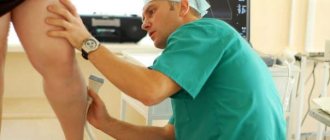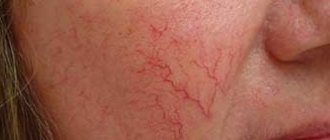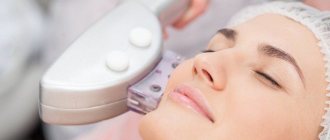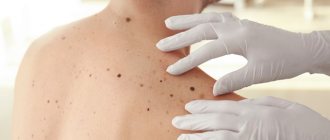Cuperosis, or vascular network on the face, is not only a cosmetic defect, but also a disease. It occurs as a result of impaired blood microcirculation, expansion of capillaries, and their fragility. The reasons lie much deeper than dermatology. Usually this is evidence of pathology of the entire vascular bed. In particular, we are talking about atherosclerosis. In this case, the walls of the vessels become inelastic and with increased blood supply they can burst, during which microscopic hemorrhage occurs under the skin.
A healthy vascular wall is capable of contracting and expanding. Externally, dilated vessels do not look very aesthetically pleasing. The skin looks inflamed. Women begin to look for ways to eliminate this defect, one of which is electrocoagulation of blood vessels on the face. Laser coagulation is no less effective, but it is more expensive than electric coagulation.
Principles of laser treatment of telangiectasia
Laser therapy is a fairly “young” direction in aesthetic medicine, which began to actively develop and be used for the treatment of skin diseases only in 1970. Despite this, laser treatment has already established itself as one of the most effective methods of combating age-related and stress-related changes, external defects (scars, scars, stretch marks, rosacea, age spots), as well as chronic inflammatory skin diseases.
In dermatology, laser therapy is also used to treat chronic infectious skin diseases (acne, acne, furunculosis) without exacerbation, since the laser flow has a powerful antibacterial effect and provides disinfection in the deep layers of the dermis. Laser light radiation is especially active against coccal flora, representatives of which are the main causative agents of skin infections.
Laser therapy helps get rid of many skin diseases
The use of laser in the treatment of vascular pathologies became possible thanks to the development of a fractional laser thermolysis technique based on fragmentary effects on the tissues of the epidermis and dermis, as well as their components (blood vessels, lymphatic ducts, hair follicles, sebaceous glands, etc.). The beam penetrates the tissues to a given depth, warms them up, as a result of which the excess blood filling the dilated vessels is “evaporated” and the walls of the capillaries stick together.
The therapeutic effect of laser therapy in the treatment of rosacea is due to the following processes occurring in the damaged vessel under the influence of laser light energy:
- absorption of laser radiation by the blood, as a result of which it heats up to 280-300, and steam bubbles form in it;
- thermal damage to the vascular wall (as a result of contact with hot steam bubbles), which causes destruction of the endothelial layer lining the vessels from the inside;
- thickening of proteins in the subendothelial lining of the vessel;
- increased activity of endothelial cells responsible for endothelial regeneration and restoration of normal blood flow;
- the formation of necrotic changes in the vascular wall.
Effect of laser on blood vessels
The meaning of the procedure is to “glue” the vessel and evaporate excess accumulated blood. The result of laser thermolysis ranges from a reduction in size and color intensity to the complete removal of blood vessels on the face.
Who is indicated for laser coagulation of blood vessels?
Laser coagulation of blood vessels (not to be confused with endovasal laser coagulation of veins, which is a medical procedure and is performed strictly in a hospital setting) can be used to treat all manifestations of rosacea, as well as scars and scars remaining on the skin after removal of moles and other neoplasms.
The use of laser on the face is effective in the presence of the following cosmetic skin defects:
- vascular points and asterisks;
- vascular networks consisting of clearly visible small blood vessels (venules, arterioles, capillaries) of red or burgundy color;
- benign tumors formed from endothelial cells lining the surface of blood vessels from the inside (hemangiomas);
- capillary moles (flaming nevi);
- tumors consisting of newly formed blood vessels (angiomas);
- symptoms of rosacea (papules, red spots, telangiectasia, pustules).
Rosacea is one of the indications for laser therapy
The number of procedures required to completely remove blood vessels on the face is selected individually and depends on the number of defects and the time of their appearance. For example, to get rid of fresh hemangiomas, 1 procedure is usually sufficient. For vascular defects, from the moment of appearance of which 1 to 3 years have passed, you will need to undergo 3-4 procedures. The same number of sessions is necessary when working with a large number of dilated vessels (vascular networks).
Note! If necessary, removal of blood vessels on the face can be carried out simultaneously with other cosmetic procedures, for example, laser rejuvenation or fractional resurfacing of scars and scars.
Consequences of removing the vascular network
Usually, after laser therapy, no complications arise - the risk of crust formation, extensive hematomas, scars and scars is minimal.
Light redness of the skin in the treatment area usually goes away within 30-60 minutes after treatment.
In rare cases, the following adverse reactions may occur:
- The appearance of a crust
- Blue discoloration of fabrics
- Swelling,
- Redness.
For such symptoms, specialists usually prescribe treatment of the affected areas with Bepanten or Panthenol. Thanks to this, the skin should recover in up to 2 weeks.
In conclusion, it must be said that complete removal of the vascular pattern on the skin cannot be guaranteed. After laser photocoagulation, the mesh will become paler and less noticeable.
Advantages and disadvantages
An important advantage of fractional laser therapy over surgical methods of vessel removal (including minimally invasive endovasal laser obliteration) is the absence of a difficult rehabilitation period. The patient can do his usual activities and return to work duties the very next day after the procedure, while pain after using the laser is practically absent thanks to the use of modern radial light guides.
Radial light guides are used for laser removal of blood vessels.
Among the positive characteristics of laser coagulation, the following are also particularly significant:
- comfort for the patient (no severe pain during laser operation and during the recovery period);
- low likelihood of side effects and complications if you follow the technique of using the device, proper preparation and compliance with the cosmetologist’s recommendations after the procedure;
- Possibility of use in patients with any skin type;
- short duration of exposure (about 15-20 minutes);
- lack of invasive intervention, reducing the risk of infection;
- high performance.
During one procedure, the doctor has the opportunity to treat several areas or large areas at once, and in most cases the procedure does not require the use of general anesthesia, which is necessary when using surgical techniques.
The procedure causes minimal discomfort
Important! One of the undeniable advantages of laser coagulation using non-ablative fractional lasers is the absence of trauma to surrounding tissues (the light flux acts only on the vessel wall), as well as deep renewal and restoration of the skin due to the activation of regenerative processes.
Disadvantages of the method
In addition to a large number of advantages, removing blood vessels using a laser also has disadvantages, including:
- high probability of relapse. To prevent blood vessels from appearing on the face again, it is important to undergo a comprehensive examination and find out the cause of their occurrence. If all provoking factors are not eliminated, the risk of re-exacerbation of rosacea will be quite high;
- short term effect. If the patient takes hormonal medications, suffers from endocrine pathologies, liver diseases, systemic connective tissue lesions, the effect of laser coagulation will last for several months, after which the vessels may appear again (but the already treated capillaries will still be much lighter);
- the need to undergo a course of treatment. In most cases, 1 procedure is not enough to completely remove spider veins and spider veins, so the patient will have to visit the cosmetologist’s office several times.
In case of significant vascular damage, several courses of laser therapy will be required.
The disadvantages of the method include the rather high cost of the course, which can reach up to 30-45 thousand rubles.
Causes
Spider veins appear for a number of reasons. Their presence on the skin of the body and face should be a signal for the patient to be diagnosed and treated by a doctor, and not just to remove this cosmetic defect.
So, the most common causes of telangiectasia are:
- Vein diseases.
- Chronic venous insufficiency.
- Endocrine pathologies.
- Hormonal disorders.
- Pregnancy, abortion.
- Taking OCs with a high estrogen content.
- Cardiovascular disorders.
- Passive lifestyle.
- Connective tissue failure.
- Lack of vitamin C (hypovitaminosis).
- Liver diseases with impaired excretion of metabolites.
Today, many beauty salons offer to remove capillary mesh, but it is not recommended to carry out this manipulation without consulting a phlebologist or vascular surgeon. It is better to solve the problem in a clinic under the supervision of qualified doctors.
How is the procedure done?
The procedure for laser removal of blood vessels on the face or other parts of the body is carried out in a cosmetology office and takes about 20 minutes. The patient is placed on a medical couch, after which a procedure is carried out to cleanse the face of dust, dirt, dead skin cells and excess sebum. For pain relief, a local anesthetic (Akriol Pro, Emla) in the form of a gel is applied to the skin. These drugs contain a combination of two anesthetics - lidocaine and prilocaine - and are used to provide skin anesthesia. The effect of the gel begins after 30-40 minutes.
Anesthetic cream "Akriol Pro"
Laser treatment is a zonal direction of the light flux to areas in which dilated vessels are located. The doctor brings the device to the skin and directs the diodes to the area where the vascular defects are located. The operation of the device is similar to flashes, during which the patient may feel dull clicks. The number of outbreaks depends on the location of the vessel, its size and the degree of filling with blood, which can be judged by color.
After the procedure, the doctor applies a soothing cream with panthenol to the face and gives detailed recommendations on skin care during the recovery period.
Important! The procedure for laser treatment of blood vessels is carried out strictly in protective glasses. These glasses are necessary to protect your eyes from burns. During laser flashes, the patient may experience involuntary lacrimation, which may also persist for 1-2 hours after the procedure. If this symptom does not go away after this time, you should consult an ophthalmologist to rule out a thermal burn of the retina or cornea.
A prerequisite is the presence of safety glasses
Useful tips
Any type of picking requires compliance with safety precautions two weeks before and two weeks after the procedure.
In particular, we are talking about the following recommendations:
- Two weeks before the procedure, it is strictly forbidden to take a course of antibiotic therapy, especially tetracycline.
- It is contraindicated to sunbathe, go to a solarium, or use self-tanning products two weeks in advance.
- It is also not recommended to treat the skin with an alcohol-containing solution for three days before the session.
After the procedure: recommendations from cosmetologists
The recovery period after laser removal of blood vessels on the face lasts on average 8-10 days. During this time, red spots (traces from the laser) may remain on the skin. The healing process of the skin is accompanied by the formation of yellow crusts that cannot be peeled off on your own. There is usually no pain during the recovery period. Only 15-20% of patients complain of severe burning and tingling at the treatment site, which subside after contact with cold air. If the discomfort is too severe, non-steroidal painkillers based on ibuprofen, ketorolac or diclofenac can be taken.
Contraindications and side effects
The likelihood of side effects after the procedure is quite low if the treatment technology (laser type, wavelength, frequency, needle diameter, operating mode, etc.) was followed during the session, and after the manipulation the patient complied with all the specialist’s instructions. The most common side effect of the laser is redness. The skin at the site of exposure looks burnt, red spots appear on it, which may be accompanied by a burning and tingling sensation. The maximum intensity of these symptoms is observed in the first three days after laser coagulation, after which the redness begins to gradually subside and the pain completely disappears.
Other side effects that may be considered as possible complications of this procedure include: hyperpigmentation, scarring, skin thickening, and skin infection. To prevent infections after the procedure, the patient may be prescribed bactericidal drugs, for example, metronidazole.
Bactericidal gel "Metrogil"
Contraindications
Contraindications for laser removal of facial vessels are:
- age under 18 years;
- malignant tumors of any location;
- purulent-inflammatory pathologies of the skin at the location of the defect, as well as any infectious diseases in the acute stage;
- tumors and other neoplasms of unspecified etiology in the immediate vicinity of the dilated vessel;
- severe mental disorders (schizophrenia, epilepsy);
- pregnancy and lactation;
- bleeding disorders and severe disorders of the hematopoietic system;
- keloid scars;
- diabetes mellitus type 1 and 2 in the stage of decompensation.
Laser therapy is contraindicated for breastfeeding women
Laser thermolysis is strictly contraindicated if you have a fresh tan. If the patient has recently visited a solarium or sunbathed in the open sun, the procedure can be prescribed no earlier than 3-4 weeks later.
Why do blood vessels reappear after laser therapy?
Laser therapy is considered a less effective method than sclerotherapy or radiofrequency ablation. If the problem reappears after a few months, it is necessary to contact an angiosurgeon and find out the cause of its occurrence, since until all provoking factors are eliminated, relapses can occur periodically.
Possible causes of the formation of vascular defects on the face include:
- connective tissue diseases (systemic lupus erythematosus, scleroderma, etc.);
- chronic vein pathologies (venous insufficiency, varicose veins);
- liver diseases (fatty degeneration, cirrhosis, hepatitis);
- endocrine disorders.
In some cases, the reasons for the reappearance of telangiectasias are external factors not related to the work of internal factors: sudden changes in temperature, intense physical activity, consumption of drinks containing caffeine and ethyl alcohol (in large quantities). In women, relapse of rosacea can be triggered by hormonal imbalances and pregnancy.
Important! If the patient is taking hormonal medications (including topical corticosteroids), the likelihood of recurrence of telangiectasias will be very high, so in cases where hormonal therapy cannot be discontinued, laser treatment is an ineffective way to combat vascular defects.
Indications for use
Usually, the indication for removal of spider veins is their presence and any degree of severity. Indications for removal are related to the severity of the pathology.
To determine the depth of the capillary network, classification according to the stages of occurrence is used:
- persistent vasodilation (the appearance of redness of blood vessels and their long-term disappearance after drinking alcohol);
- determination of vascular pattern (dotted, root-shaped, linear, arachnid);
- visible progression of rosacea (lack of vascular contractility);
- the formation of inflammatory or stagnant processes (blood circulation is impaired).
Even the initial stage of development of the pathology is displayed as an unpleasant defect on the face, significantly spoils the external attractiveness, and is difficult to disguise with decorative cosmetics.
The main indications for removal of rosacea are the patient’s desire for ideal facial skin, the ineffectiveness of alternative procedures or treatments, and late stages of development of rosacea.
Methods for correcting facial contours at home and offers from cosmetology clinics. Watch here a video of the procedure for chin augmentation with fillers.
At this address https://cosmetolog-expert.ru/plastika-litsa/nos/rino/kak-umenshit-bez-operatsii.html we will tell you how to reduce the width of your nose without surgery.
Cost of the procedure
The cost depends on the location of the defect and its area. Approximate prices for laser removal of blood vessels are shown in the table below.
Cost of laser treatment for telangiectasia on the face
| Processing area | Cost of 1 session |
| Wings of the nose | 2000 rubles |
| Cheeks | 3000 rubles |
| Full face and neck | 7500 rubles |
| Full face | 6200 rubles |
| Face, neck and décolleté | 8600 rubles |
Photos before and after
Photos before and after removal of blood vessels with laser No. 1
Photos before and after removal of blood vessels with laser No. 2
Photos before and after removal of blood vessels with laser No. 3
Removing dilated vessels on the face using a laser is a fairly effective, comfortable and safe way to correct the external manifestations of rosacea. In most cases, the problem can be dealt with in 1-3 procedures. Laser therapy is a more gentle way to get rid of telangiectasia compared to surgical methods, therefore it is increasingly used in aesthetic medicine and hardware cosmetology. If the patient is healthy and adheres to a normal lifestyle and routine, spider veins after laser treatment do not return for a long time.
What devices are used to perform laser removal of blood vessels on the face?
Removal of spider veins on the face is carried out using such devices as:
- Neodymium laser is a device that is considered the most effective in the fight against rosacea. Laser wavelength 1064 Nm. Using this type of laser, you can remove any type of dilated capillaries, both deep and superficial. The light beam is evenly distributed in the epidermis without overheating healthy tissue. The neodymium laser has a modern cooling system, which prevents thermal burns.
- The diode laser has a pronounced point flow, which makes it possible to remove vascular pathological neoplasms.
- The BBL photosystem removes port-wine stains, rosacea and rosacea. The method allows you to get rid of spider veins in 1-2 procedures. The area of influence of the laser beam is 3 sq.cm. for 1 flash of the device.
Laser equipment for removing rosacea
The type of device for laser coagulation is determined by a dermatologist depending on the severity of the patient’s cosmetic problem. Recently, the BBL photosystem has been most often preferred.
May be of interest:
|











